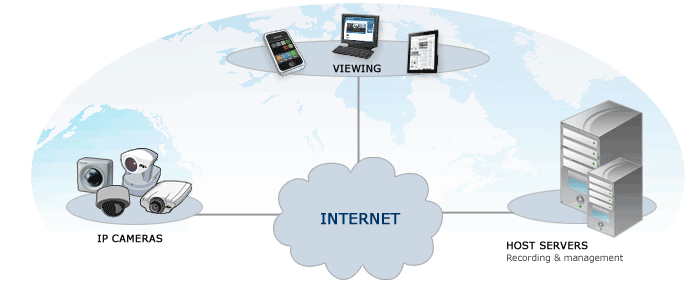VSaaS (Video Surveillance as a Service) Explained
What is VSaaS (Video Surveillance as a Service)?
Software as a Service (SaaS) is a software delivery model that is sweeping the IT world. Software and associated data are centrally hosted in a cloud computing environment and accessed over the Internet. This differs from the traditional model of software delivery, where software is purchased and installed on a desktop or workstation.
Video Surveillance as a Service (VSaaS) takes video monitoring into the cloud. Sometimes referred to as hosted or managed video services, video from customer IP cameras or webcams is transmitted to the service provider’s secure cloud infrastructure.
Dos and Don’ts of a VSaaS System
1) Do more for less. A VSaaS system when used with an existing webcam or IP camera for monitoring can be very cost effective (or cost free) for an individual consumer or a small to medium business.
2) Don’t require users to install software on individual computers and manage software updates. A key benefit of the SaaS delivery model is the use of cloud storage and web standards to access data over the Internet using a web browser. When the hosted video monitoring service is accessed in a browser, the user always has access to the latest version of the software. Video should also be stored in the cloud on secure servers. Local storage is more prone to theft, hacking and physical damage to the storage device.
3) Do consider image quality and bandwidth usage. A cloud video monitoring solution is well suited for highly efficient video compression algorithms, such as H.264/MPEG-4 AVC, and reduced framerate and resolution. When transporting video over the Internet, inefficient formats such as MJPEG and MPEG-4 Part 2 use too much bandwidth which severely limits the number of cameras that can be supported.
4) Do leverage the cloud infrastructure for remote access. Self-monitoring through a VSaaS provider enables secure accessibility from any Internet-connected location and through mobile devices.
Tradeoffs: Self-Monitoring versus Professional Monitoring
The Security Market Intelligence blog evaluated the pros and cons of self-monitoring versus professional monitoring, concluding that:
“…the decision of whether to professionally monitor or self-monitor is a trade-off of cost versus the level of required protection. If the site requires a high level of security then the end user typically opts for remote video monitoring or manned guarding. Whereas if the end user only wants the peace of mind from occasionally checking in on their site, a self-monitored remote service is typically chosen.”
This IMS Research has an excellent chart that visualizes the tradeoffs between cost and the level of security required. It does a nice job of clarifying the various types of offerings in the broader VSaaS market.
The IMS Research chart suggests that VSaaS and Remote Self-Monitored Video providers are more costly than traditional Non-Video Alarm Monitoring. We disagree on this point as the cost of DIY IP video monitoring can be quite low, leveraging the economies of cloud computing and passing them on to the consumer. Services like the one we offer, Camcloud, provide hosted video monitoring with a free usage plan targeted at consumers and small-medium businesses, that is fully mobile enabled. In previous posts we have explored the high on-going cost of alarm monitoring provided by traditional alarm companies and medium-large MSOs, which often requires a multi-year contract and installation services.
The Future of VSaaS: Consumerization of Cameras and Cloud Services
With an estimated 30+% market share, Axis Communications continues to dominate the global IP camera market. Axis recently partnered with Salient and HP to provide system integrators with a complete solution that is cost effective, is simple to install and configure, and that uses remotely hosted servers and storage. This partnership is targeted at the Professionally Monitored Video segment, and normally includes value-added security integration services. Axis provides a rich set of APIs that allow service providers to add an enhanced management layer to control sets of installed cameras. Companies such as D-Link, Logitech, and others, offer consumer-grade cameras which tend to be less expensive, but also less extensible as they are typically designed to work specifically with that vendors other hardware and service offerings. We expect the inverse relationship between cost and functionality to continue. IP cameras will continue to see price reductions, while at the same time becoming easier to install and operate.
This consumerization of cameras, coupled with accepted web video standards such as H.264 also enable lower cost webcams to be used as a video monitoring source. This will further open the door to consumer adoption, making VSaaS and remote self-monitored video available to the masses.
VSaaS is growing and the technology and consumer awareness trends show no slowdown. A new report by the research company and consulting firm Markets and Markets reviewed VSaaS and it’s key application spaces – commercial, institutional, residential, industrial and infrastructural, reporting that the global video surveillance as a service market is expected to grow from $474.0 million in 2011 to $2.39 billion in 2017 and achieve a compound annual growth rate of 31.5%.



No Comments